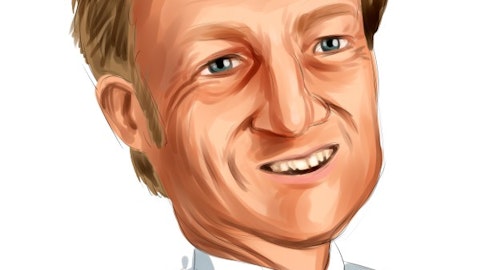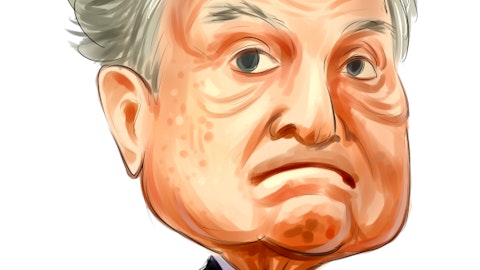Jasper Bibb: Thanks. And then wanted to ask what you’re seeing from a new sales and pipeline perspective. And has there been any change with respect to the mix of new outsourcing opportunities and competitive takeaways?
John Zillmer: No, I’d say the pipeline continues to be very robust. We’re very pleased with the results to-date and have a lot in the pipeline that we’re working to close. And so we’re very encouraged by what we’re seeing so far. And no change in the level of outsourcing activity, it’s still, our pipeline is as big as it’s ever been. So without getting into specific opportunities, we’re very encouraged.
Jasper Bibb: Appreciate the detail there. Thanks for taking the questions, guys.
John Zillmer: Thank you.
Operator: Our next question comes from Heather Balsky with BOA. Your line is open.
Heather Balsky: Hi, thank you. I guess, I’d like to add on to the prior question with regards to your pipeline, and just when you think about the different segments you’re in, where you might be seeing the most demand, and also kind of how you think about the right mix for your business in terms of the end markets you want to be in.
John Zillmer: Well, very — we’re seeing very broad-based opportunity both domestically and internationally. And we’re — really we’re seeing it across all the businesses, whether its workplace experience or Collegiate Hospitality, significant opportunities in healthcare, significant opportunities arising in virtually every vertical. So it’s really — we’re in the businesses we want to be in. We’re focused and we’re resourced to grow all of them. And we’re seeing opportunity literally in every market that we serve. So that’s what makes it so encouraging. There is no — I’m not limited to one particular vertical or another, one business or another. We’ve got a range of opportunities that we can pursue, and our people are delivering across the Board both domestically and internationally. And that’s what makes the growth story so exciting.
Heather Balsky: That’s really helpful. And I’m going to ask an inflation question, which is I think a lot of investors are also looking or reading what the food distributors are saying and seeing. You don’t necessarily report at the same time. I’m curious kind of when they talk about pricing, for example, center of the plate, you — how we’re looking at your food costs should be thinking about things because presumably you have a different business mix than the food distributors have in terms of what they’re selling. Does any kind of color you can provide that helps us kind of interpret what they’re saying and what it might mean for your business?
John Zillmer: Yes. That’s a great question, Heather, and it’s one that is — that can be a little bit confusing given the kind of numbers that they report, which are really focused more on commodities as opposed to the market basket of products that we buy. And our inflation numbers are very specific. It’s the products we buy from the — that our clients and our customers want us to serve. So ours are — we look at this number literally on a weekly basis. We know exactly what we’re paying for goods and services across the enterprise by business unit by country. So we have a high degree of correlation to what our market basket costs are. The distributors do have much more spot kind of exposure to various commodities. Typically, our contract pricing normalizes for that.
So it’s very hard to make a direct comparison between the distributor costs and our costs. And — but I would say as you see commodity pricing modulating, you’ll see that eventually transfer into lower prices to our products that we buy and utilize as well. So tough to make the correlation, but always happy to confuse you further if that hasn’t helped.
Heather Balsky: We appreciate it. The more confusion the better, I guess. Thanks very much.
John Zillmer: Thank you.
Operator: Our next question comes from Toni Kaplan with Morgan Stanley. Your line is open.
Toni Kaplan: Thanks so much. In the past, you’ve had some creative technology initiatives that you’ve deployed. Can you talk about where you’re focusing on innovation and any AI initiatives in particular?
John Zillmer: Yes, that’s a great question, and both Jim and I can comment on this. It is a very significant initiative inside the company to apply technology to the parts of the business where we can really benefit both the frontline managers as well as the customer. And literally had a report to our Board meeting last week on the technology initiatives underway inside the company. And some that are the most prevalent, as you might expect are things around menu design and menu optimization using AI technologies to go ahead and evaluate customer needs, sets and optimal menu structures to serve them. And we literally have pilots going on multiple businesses for menu optimization both from a cost perspective as well as a customer acceptability perspective, because you can use AI to create the lowest cost menu in the world and guess what?
Nobody will buy it. So you have to have — you have to balance both of those objectives. And so we’re using the large language models and AI to go ahead and develop programs that really optimize both for us as well as the consumer. And it’s very exciting and the pilots have shown dramatic results and we’re very encouraged by what the possibilities are.
Jim Tarangelo: Yes, I’ll just add to that. We’re seeing good opportunities as I mentioned in my script. We’re utilizing AI within our supply chain group to harmonize our spend data. And that AI is enabling really effective and optimizing our matching and aggregation of SKUs across the Board and enables us to negotiate better pricing with our suppliers and manufacturers.
Toni Kaplan: Terrific. Wanted to follow-up on competition. Are you seeing any changes in the market with regard to either the large competitors or even the smaller mid-size competitors in the space?
John Zillmer: Yes. I would say the short answer is no, really no change. It’s always been a very competitive environment. We’re all pursuing those brand name clients all the time, and the range of competitors continues to evolve and change. Still plenty of regional companies out there, smaller organizations positioned against certain businesses and niches that they like. But overall, I’d say it’s a very disciplined competitive environment, really no change to economic structure, bidding strategies. We are always focused on selling quality and customization, and that’s what we continue to focus on. And frankly, we’re seeing our competitors also doing the same thing. So we like the environment, we like the opportunity. And I would say it’s been very consistent over the course of the last several years.
Toni Kaplan: Terrific. Thank you.
John Zillmer: Thank you.
Operator: Our next question comes from Neil Tyler with Redburn Atlantic. Your line is open.
Neil Tyler: Hey, good morning. Thank you. And a couple from me please. And just go back to the margin and the way you think about achieving the — what hitting the midpoint and the components contributing to that. And the question is really over the remainder of the year, do you expect the bridge, if you like, year-on-year in terms of the relative contribution of things like price versus inflation, ramping new volumes and the GPO, do you expect that sort of contribution to remain consistent or for those components of the change in terms of their relative importance as we move through the year? That’s the first question. And then second question on the base business ramp up and I’m particularly, I suppose, in the International business.
Just wondering if you could talk a little bit more about the — what’s going on there and whether to what extent there is a sort of acceleration in volumes in relatively recently won contracts that might not be classified as net new, but still seeing a sort of normalization upwards. Thank you.


